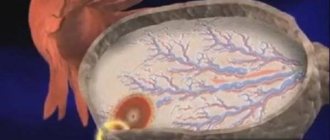Symptoms after examination by a doctor
Discomfort after the examination persists for several days, and this cannot be called a deviation from the norm. However, acute pain should alert the patient. Sometimes during an examination, doctors examine the condition of the cervix and vagina too roughly - this causes injury to the mucous membrane and some other disorders.
To understand why the lower abdomen hurts after an examination by a gynecologist, it is enough to study the manipulations performed by the doctor:
- using a gynecological speculum, a specialist examines the vagina and cervix - this instrument does not have sharp corners, but can damage the membrane if the woman’s muscles are too tense;
- during the examination, the doctor takes a smear from the mucous membrane in order to send it for tests, sometimes it is necessary to collect cells from the cervix, during which slight irritation of the organ also occurs;
- A bimanual examination is carried out with your hands, palpating the organ from the inside and outside of the abdomen - excessive pressure will result in painful sensations after a while.
Normally, the pain goes away after some time - 1-2 days, but this symptom cannot be ignored, since in some cases it indicates a disease.
Women who do not have regular sex life, as well as patients over 50-55 years of age, are especially susceptible to painful sensations. With age, the amount of lubrication decreases, the muscles weaken - this provokes unpleasant sensations.
How a scraping is taken
It has been established that this procedure does not cause any discomfort or pain. But there are several factors to consider. If an inflammatory process develops in the vagina during sampling, then any intervention will cause discomfort.
Also, to obtain a reliable result, it is advisable to take not the surface cells, but those that are located deeper. The doctor will have to lightly press on the mucous membrane or even pinch off part of it.
Therefore, there is no need to be nervous if you feel slight pain. Next, the doctor will place the resulting material on the prepared glass. When the smear dries, it can be sent to a medical laboratory.
Once the procedure is completed, the patient can go about her usual activities. But there is a possibility that the vaginal mucosa may bleed after taking a smear.
If this phenomenon occurs within 1-2 days, it does not require treatment and is normal. But if a cytology smear bleeds for more than a week or severe pain in the lower abdomen and fever appear, then this is a serious cause for concern.
Do not self-medicate, consult a gynecologist. Prolonged discharge after cytology indicates gross, unprofessional intervention by a doctor, which could lead to stenosis and adhesions.
Dangerous symptoms
Painful sensations after examination, especially acute pains that require medication and are difficult for women to tolerate, are a sign of inflammatory processes in the pelvic organs.
During diagnosis, the doctor may suspect their presence or will definitely indicate a particular disease. Symptoms may appear some time after examination. You should immediately contact a doctor if the patient’s condition worsens, weakness appears, blood pressure drops or rises, heavy bleeding occurs and the temperature rises.
Dangerous symptoms may be associated with damage to the ovarian cyst, but with an instrumental examination this is unlikely.
Acute pain sometimes develops in women with insufficiently strong pelvic muscles. This is a non-pathological condition, you just need to endure it and think about strengthening your muscles.
Diagnosis of the condition
If the pain persists, the woman should see a doctor. An ultrasound of the pelvic organs, a general analysis of urine and blood are prescribed. It is imperative to study the analyzes of smears taken earlier. It is advisable to carry out the procedure where the results are provided to the patient within a day.
If a routine examination does not reveal anything, it is necessary to undergo further diagnostics - an MRI of the pelvis and peritoneum, as well as a detailed blood test. Consultation with an oncologist and hematologist may be required.
How to relieve pain
To avoid painful sensations, you need to remember some rules:
- It is better to carry out hygiene procedures before visiting a doctor without soap, which can dry out the mucous membrane;
- to prevent pain during palpation, it is necessary to empty the bladder;
- to prevent the development of diseases, you must consult a doctor if any signs of disturbances appear;
- if pain does occur, but it is not associated with diseases, you can take No-Shpu or drotaverine, papaverine.
You can take 1 tablet of NSAIDs such as Nurofen or Tempalgin, however, if unpleasant symptoms persist, further use of such medications is prohibited.
Painful sensations without additional symptoms are in most cases a normal indicator after examination by a gynecologist. However, these signs may hide inflammatory processes and other disorders. It is important to monitor your condition and seek re-diagnosis if pain persists for more than 3-4 days.
Source
What does a cytology smear show and how to interpret the results?
A cytology smear in women shows how much the cells of the cervix have changed recently. As soon as the doctor begins to examine the sample under a microscope, he will be able to find out the following indicators:
- cell structure, size and shape;
- pathological modifications of the epithelium and its structure;
- the number of each cell element.
The results obtained can be divided into 5 possible types of smears, or cytological prints. The breakdown of the oncocytology analysis looks like this:
- 1 type of smear – negative indicator. This result is considered normal, the woman is healthy and no pathological abnormalities were found in her.
- Type 2 smear - the presence of some changes in the cells that are inflammatory in nature. An inflammatory type of smear is a signal that a woman needs to see a doctor for additional tests and to identify possible causes of the infection. As a rule, a repeat cytological analysis follows after 2-3 months.
- Type 3 – the presence of a small number of cells of an abnormal structure. Changes in the structure and structure of cell nuclei will indicate the need for histological and microbiological diagnostics. The presence of the disease will be established only after receiving its results. Such indicators most often indicate cervical dysplasia.
- Type 4 – high probability of a malignant tumor. A smear taken for examination reveals cells with malignant changes in the cytoplasm, nucleus and chromatin. Additional procedures are required to clarify the condition: colposcopy, biopsy.
- Type 5 – presence of oncology. If the previous type indicated the initial stage of development of malignant formations, then the fifth indicates the active course of the cancer process. Such poor cytology results will indicate the need for serious and qualified treatment. Additional tests will be required, but rather to determine the extent of the disease.
Deadlines
The first visit to a female doctor should occur before the first sexual intercourse immediately after the girl reaches puberty. Gynecologists recommend coming for a routine examination once every six months.
When a woman begins menopause, she needs to visit the doctor much more often due to the fact that during this period the risk of developing oncological tumors on the organs of the reproductive system increases. The choice of a medical specialist, in this case a gynecologist, with whom women will be observed, is very important.
This is important because the most experienced gynecologist will not be able to provide a full examination of the patient without specialized equipment. The availability of tools and accessibility to laboratory tests increases the possibility of diagnosing the disease and, accordingly, prescribing therapy to eliminate it.
To be perfect, a woman should choose the right doctor for herself and see him constantly. Over time, the doctor will know all the features of her body.
Conversation
Before visiting a gynecologist, you need to think through all the troubling questions that are important to get answers to. Also accurately formulate the answer to the question: what is troubling you at the moment.
At the appointment, the doctor will collect a medical history, which includes the following information:
- complaints and symptoms that cause discomfort to the patient;
- the presence of menstruation and its course;
- number of pregnancies that resulted in childbirth;
- abortions, miscarriages;
- use of contraception;
- the presence of chronic diseases in you and your relatives.
Inspection
After collecting information, the doctor will begin directly examining the patient on the gynecological chair. It is during this period that a woman begins to worry and has a huge number of fears and worries that now it will be very unpleasant and painful.
If a gynecological examination is carried out correctly, the gynecologist receives the information he needs about the condition of the pelvic organs, as well as the presence of gynecological diseases. Chair examination is a safe and very informative research method.
There are a number of recommendations that will help you prepare properly before visiting a doctor and minimize the occurrence of possible unpleasant sensations. Particular attention must be paid to psychological preparation.
At the first visit to the gynecologist, it is natural for a woman to feel embarrassed, which should disappear during subsequent visits, since the patient must understand that her health depends on regular gynecological examinations, because timely identification of problems increases the chances of complete relief from it.
A woman must not forget that in front of her is an experienced doctor who conducts a huge number of gynecological examinations every day, during which he will try to cause the woman a minimum amount of not only psychological, but also physical discomfort.
A gynecological examination is a painless procedure. All instruments used during the examination of the patient on the chair do not have sharp corners or edges. During the examination, the gynecologist uses disposable gynecological instruments included in the kit that the patient brings, and also puts on new rubber gloves. The use of disposable towels, mirrors, gloves and other materials eliminates the risk of infection.
On the armchair
When a woman goes to see a gynecologist, she needs to dress so that the undressing procedure does not take a huge amount of time. After this, you need to put on the shoe covers that come with the kit. This is necessary in order not to walk on the floor in socks. The procedure itself generally lasts no more than 10 minutes and consists of several stages, namely:
- examination of the vagina and cervix using a special gynecological speculum;
- collection of biomaterial from the cervix and vaginal walls for further study under a microscope;
- bimanual examination.
When the gynecologist inserts a speculum into the patient’s vagina, you need to relax as much as possible, fold your arms over your chest and try to breathe deeply and evenly. After a full examination of the genital organ has been carried out, the doctor takes smears from the cervix, vagina and external opening of the urethra. This manipulation allows you to fully assess the state of the microflora and identify the possible presence of viruses, bacteria and other harmful microorganisms.
The final stage of examining the patient in the chair is a bimanual examination. During this manipulation, the doctor feels the vagina with one hand and the abdomen with the other. This method allows you to assess the location of the pelvic organs, their structure, and so on. In virgins, the examination is carried out through the rectum.
What does a cytology smear show and how to interpret the results?
Doctors say that all women over the age of 18 who care about their health should have a smear for a cytogram. But not every patient listens to this advice.
- Irregularity of menstruation. If they occur less frequently or more often than usual, then you should consult a gynecologist.
- Pregnancy planning. A cytological smear from the cervix will reveal the likelihood of infertility or the presence of other pathologies that affect conception.
- The presence of infections of a chronic nature that are associated with the reproductive system. This group also includes cervical erosion.
- Checking the health of the body before surgery or other complex operations.
- Taking hormonal or contraceptive medications.
- Grade 1 cytology is required if you are going to install an intrauterine device.
- Overweight or obesity 2-3 degrees.
- Detection of harmful viruses in the body (herpes in the genital area, papillomavirus).
- Diabetes.
Normally, the analysis should be performed on
day of the cycle. The collection of material for cytological examination of smears is carried out by a gynecologist in his examination room. This is done before conducting a two-finger manual examination and before colposcopy.
First, the specialist places a gynecological speculum in the vagina, after which he cleanses the cervix of various secretions using cotton wool. After this, the doctor uses a special brush to scrape the side of the vagina and vaginal vault, as well as the endocervix.
The taken material is applied in a thin, uniform layer to the previously disinfected glass. To prevent the cytological smear from drying out, it is treated with a mixture of ethyl alcohol and ethers.
Some specialists use aerosols for this or place the material in a test tube with a special liquid. Store smears at a temperature of 2-8 degrees for no more than 10 days. Taking material for cytology can cause discomfort.
The frequency of analysis for oncocytology is determined by the gynecologist based on the condition of the patient’s body.
18-65 years old,
If there are pathologies of the cervix or if the oncocytological smear performed last time turned out to be “bad”, it is recommended to conduct the study once a year.
In women over 65 years of age, the frequency of cytological analysis depends on the medical history and the results of previous studies. An analysis for oncocytology is required before and after pregnancy, but in some cases it may be necessary to conduct an analysis during gestation.
As a rule, this study is recommended for women who were found to have atypical cells when planning pregnancy. Based on the results obtained, the patient will be prescribed treatment during pregnancy or will receive it after childbirth.
It is important to note that the cytological analysis is absolutely safe for both the woman and her child, and the presence of poor results in no way means that she will not be able to conceive, bear and give birth to a healthy child in the future. This analysis should not be neglected.
- Correct cell structure, absence of any pathology.
- The presence of minor changes in the cervix (mild dysplasia).
- The presence of single pathologically altered cells (severe dysplasia or moderate dysplasia).
- Strong changes in the nuclei, cytoplasm, and chromosomes of several cells indicate suspicion of cancer.
- There are a lot of cancer cells, the reliability of the results is beyond doubt.
After taking a smear for cytological analysis, a woman may notice greenish or brownish discharge. This should not be a cause for concern, as it is a normal reaction of the body to the procedure.
To avoid discomfort, you can avoid intimacy for a week. Unfortunately, some women may experience complications after an oncocytology test, which manifest themselves in the form of abdominal pain, fever and stenosis.
As a rule, this happens if the material was collected extremely carelessly. In this case, it is recommended to seek help from a qualified specialist.
After receiving the results, women often begin to worry and wonder what the cytology smear shows in their case.
Recommendations
When the examination is carried out by an experienced and qualified specialist, then all his manipulations are painless in the case when the patient does not have any diseases of the pelvic organs or other pathological changes and processes. During the period of a preventive examination, a healthy patient may only experience minor discomfort, which passes very quickly.
In order to avoid pain during the examination, it is necessary to carry out proper preparation for it. The first thing you need is to get in the right mood, especially if this is your first visit to a women's doctor.
In order to reduce vaginal dryness, while minimizing discomfort during the examination, before going to the doctor, you need to carry out hygiene procedures without using soap, which leads to drying out the mucous membranes of the genital organ.
There are cases that after examination, bloody discharge from the uterine cavity may appear. If the discharge is not accompanied by pain, then there is no reason to worry. The appearance of brownish discharge in small quantities can be caused by damage to the vaginal walls during the collection of biomaterial.
During this period, slight pain in the lower abdomen may also appear. Such pathological changes should completely disappear after a few days. If this does not happen, you need to visit the gynecologist again and find out the exact cause of the discharge and pain in the lower abdomen.
By following all the recommendations, you can reduce the discomfort that occurs during the examination, as well as possible pain after it.
Source
What symptoms may bother you after a gynecologist?
To maintain the health of the reproductive system, women are recommended to undergo a routine examination with a gynecologist at least once every 6 months. In some cases, after the examination, a woman may experience a feeling of discomfort or notice unpleasant symptoms (most often pain or spotting). All this can cause anxiety and fear for your own health.
| Appointment with a gynecologist with the highest category | 1000 rub. |
| Consultative appointment with a doctor based on test results and ultrasound results | 500 rub. |
| Extended colposcopy | 1500 rub. |
| Amino test for bacterial vaginosis | 300 rub. |
| Medical abortion (all inclusive) | 4500 |
| Make an appointment by phone: 8-800-707-15-60 (toll-free) |
| *The clinic is licensed to remove tumors |
Abdominal pain
Sometimes abdominal pain after examination by a doctor does not pose a threat to a woman’s health. Most often, pain in the lower abdomen occurs in women who do not have regular sex life and in those who have entered menopause.
This is due to the fact that in women after 50 years of age, the vaginal muscles lose their elasticity, which may cause discomfort and pain after examination by a gynecologist. Taking gynecological smears may also cause mild pain.
Cervical erosion can also cause pain. This disease is easily diagnosed during examination. To get rid of erosion, the doctor prescribes appropriate treatment for the woman.
After an examination by a gynecologist, the lower abdomen hurts: normal or abnormal?
Quite often, women complain that after a gynecologist their lower abdomen hurts. This discomfort may last for several days after examination by a gynecologist. The pain is nagging or sharp in nature, which causes natural concern in the patient.
Such a reaction can actually be observed after taking it; it is caused by the peculiarities of the procedure being performed, the presence of pathologies or diseases in the woman, and the inexperience of the doctor.
Pain in the lower abdomen after a visit to the gynecologist is a fairly common occurrence.
What is included in a gynecological examination
Pain after examination by a gynecologist may be due to the specifics of the procedure, which takes about 10 minutes. It includes:
- Examination of the vagina and cervix using a special gynecological speculum. The tool has no sharp corners and is therefore safe. At the time of insertion, the woman may feel some discomfort, so you need to first relax the vaginal muscles.
- Taking a smear from the mucous membrane of the internal genital organs for further microbiological examination. Cytology of the cervix can also be performed - the collection of cells to determine their normal development and the absence of mutation processes.
- Bimanual examination. The doctor palpates the organs inside with one hand, and the outside of the abdomen with the other. This is how the correct location of organs and their development are determined.
Suturing the cervix
In patients at high risk, cervical monitoring is carried out at 12 weeks, checking how low the cervix is. The operation of suturing the cervix (suture) allows you to preserve the pregnancy, since it is the closed state, without allowing the cervix to open, that allows you to hold the fetus and protect it from infection. Cervical dilatation is isthmic-cervical insufficiency (ICI) or weakening of the uterine muscles. Pregnancy can shorten the cervix, which also makes surgery more difficult. If the indications for the operation and the vital activity of the fetus are confirmed, doctors apply a suture, protecting the fetus and the patient from premature birth, warning of possible pain after the operation. Possible pain after suturing the cervix:
- Nagging pain with the tone of the uterine walls (the anterior wall of the uterus and, accordingly, the posterior wall of the uterus, these are the points of attachment of the placenta, and methods for determining the presentation of the fetus);
- The lower back begins to hurt and the lower abdomen ache;
- A feeling of heaviness, as if the fetus were pressing on a suture;
- If it hurts to sit down, try to walk around a little, stretch your legs, or better yet, if you are at home, lie down;
- If you have discharge containing a bloody clot, it is better to inform your doctor.
Helps determine how successful the suturing was: a follow-up visit to the attending physician, ultrasound diagnostics.
At week 37, the doctor will decide to remove the suture to prepare the woman for childbirth; after the procedure, the baby can be born at any time.
Attention! If nagging pain and heaviness continue for more than a few days, this is a sign of complications and you should call a doctor.
Why does the lower abdomen feel tight after being examined by a gynecologist?
If your lower abdomen hurts after visiting a gynecologist, there may be several reasons for this:
- Presence of gynecological diseases, inflammatory processes. These include, for example, cervical erosion, ovarian cysts, endometriosis, inflammation of the appendages, etc. Before examination at rest, the pathology did not cause pain, but after palpation or insertion of a speculum, a characteristic symptom appears. If your stomach hurts inside after the gynecologist even on the second day, contact your doctor.
- Weak muscles of the pelvic organs. Manipulation with them causes pain.
- During the collection of biological material, intentional minor damage to the mucous membrane of the cervix is carried out. This is somewhat painful and can also provoke bloody discharge.
Taking a smear and biomaterial can cause pain in the lower abdomen.
Weak muscles and pain in the lower abdomen after examination by a gynecologist
If, after an examination by a gynecologist, pain appears in the lower abdomen, it is worth answering the question of whether the vaginal muscles are sufficiently prepared. This problem is typical for women who have an irregular sex life and do not have additional stress, for example, in the gym.
The second category of women who may suffer from abdominal pain after examination by a gynecologist are mature patients. With age, muscle tissue loses its elasticity. Also, lack of lubrication in some cases leads to microtrauma of the mucous membrane.
Cervical amputation
A low-traumatic surgical intervention prescribed for pathological conditions of the genital organs. Amputation is prescribed for patients:
- In the early stages of cancer, which is detected if there is pain with cervical cancer. This pain is characterized as a lumbago in the lower back, sacrum, lower abdomen, rectal area, pain in the left side and left thigh. Added to the pain are foul-smelling bleeding, spotting and leucorrhoea. In advanced cases, cervical cancer is characterized by the appearance of contact bleeding resulting from minor injuries, such as cycling, pain in the cervix when walking, etc.
- Analysis of cervical cells revealed malignant changes;
- With a hypertrophied cervix;
- With chronic endocervicitis;
- With ectropion, when the mucous membrane of the cervical canal is inverted;
- With the regular appearance of erosions;
- With a deformed cervix, when uterine prolapse is noted.
If the pain after amputation of the cervix is very severe, an anesthetic is prescribed. These pains include:
- The pain from the installed urinary catheter is temporary, as it will be removed very quickly;
- It begins as if it were shooting in the lower back;
- As if it begins to pull in the lower abdomen, in case of lifting weights of more than 4-5 kg;
- Painful dryness in the vagina and around the entrance.
Even after amputation of the cervix, a woman retains reproductive function (menstrual cycle, ovulation, fertility), and is able to give birth, the main thing is to follow the doctor’s recommendations and be careful in the postoperative period. If symptoms persist and a biopsy reveals the presence of malignant cells, a hysterectomy may be required - amputation of the patient's uterus, in which, after removal, a stump, the remnant of the genital organ, will remain.
Attention! With any, even gentle, surgical intervention in the genital organ, the decision to resume sexual activity is made only by the doctor.
Video: What happens after cauterization of erosion
Need to cauterize! What happens after cauterization? (norm and pathology)
Video: Myths about erosion
Myths about erosion - Everything will be fine - Issue 374 - 04/15/14 - Everything will be fine - Everything will be fine
Video: cervical erosion is cured
Cervical erosion is cured
Examination during pregnancy
Gynecological examination during pregnancy is carried out in the early stages. At the same time, it is carried out more carefully so as not to provoke contractions. In order for the doctor to take into account existing circumstances, during the consultation you need to warn him about your situation or suspicion of it.
If, after an examination by a gynecologist, a pregnant woman’s stomach or lower back hurts, this may be a reaction of the uterus to the manipulations being performed (it begins to contract). This condition is dangerous due to the possibility of spontaneous abortion (especially if the patient is stressed). In this case, you must immediately notify the doctor about the problem that has arisen.
Proper preparation for visiting a doctor will help you avoid pain during and after the procedure.
How to avoid pain after a gynecologist?
To eliminate pain in the lower abdomen after a gynecologist, you should adhere to the following recommendations:
- Before the examination, you should not perform hygiene procedures using soap. It dries out the mucous membrane and leads to injury.
- The uterus is located in close proximity to the bladder, so upon palpation it should be empty so as not to cause pain and discomfort.
- Consult a doctor promptly if there is the slightest deviation in your health: changes in discharge, pain during sex, bleeding, etc.
Make an appointment with an experienced gynecologist using the link. You can also get a free consultation here.
Pain
It is recommended that all representatives of the female half of the population visit a gynecologist at least once every six months. Unfortunately, most women turn to a gynecologist only when various problems and diseases of the reproductive system arise.
After an examination in a gynecological chair, patients very often complain of pain in the lower abdomen that occurs immediately after the examination. This phenomenon can be triggered by various factors, including the presence of certain gynecological ailments.










